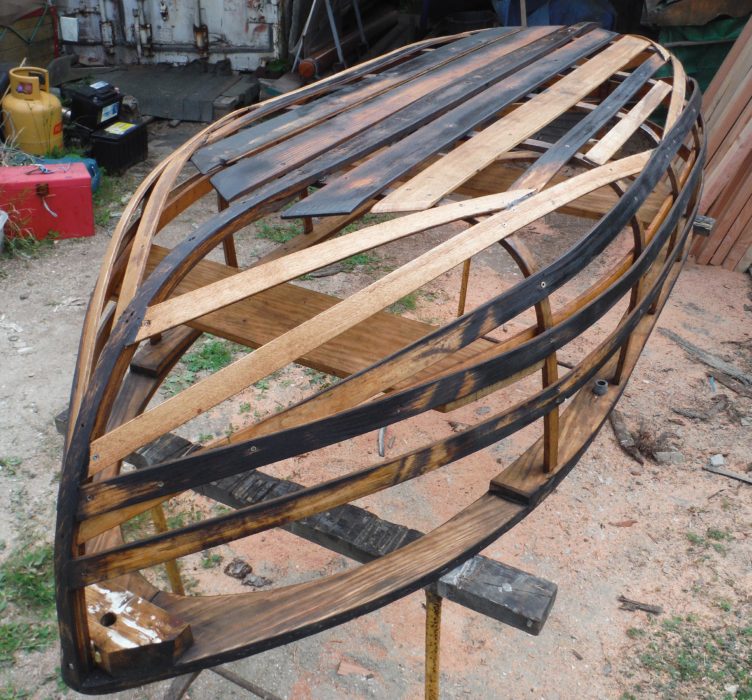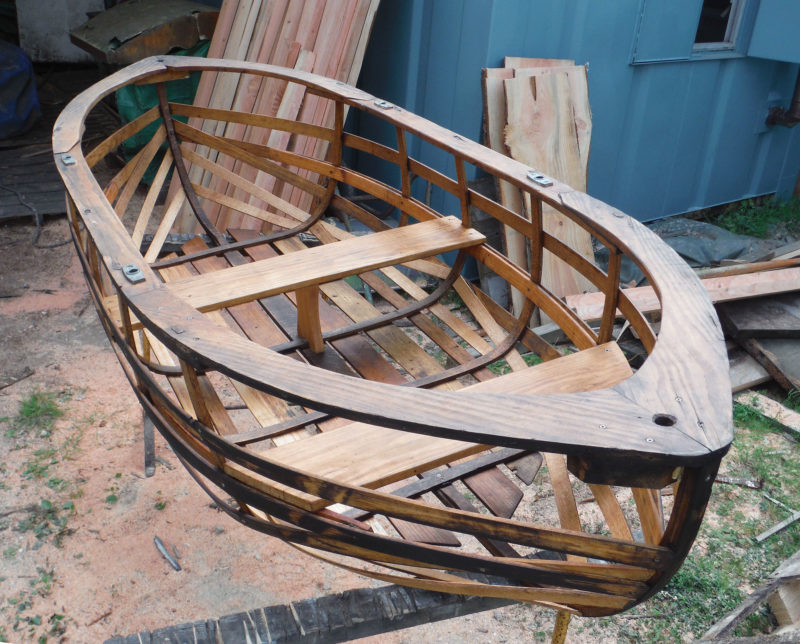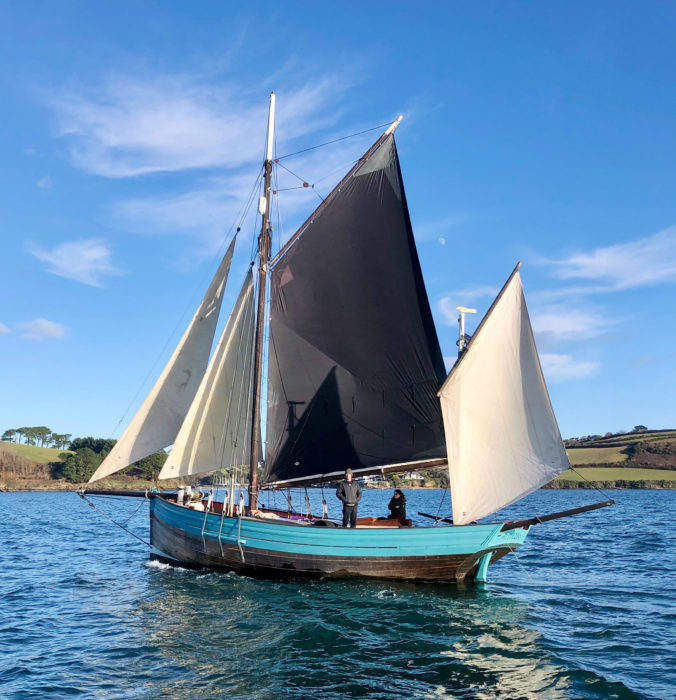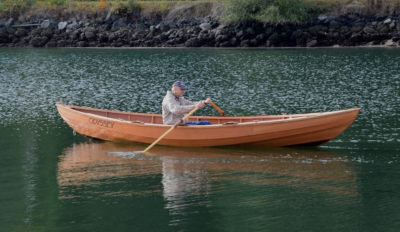James Baker, his wife, and their two young daughters live aboard LIVELY, a 42′ wooden gaffer that James built in the traditional manner of a turn-of-the-20th-century Cornish workboat and launched in 2015. For a four-month cruise around Ireland and along the west coast of Scotland, planned for the spring of 2019, James thought a single tender wouldn’t give his family and the occasional crew members the flexibility needed for the anchorages they’d visit. There was space on board LIVELY for a second tender 8′ long with a beam of 3′. Whatever was to occupy the space had to be in keeping with the look and feel of the gaffer.
While James and his family live in Penryn on England’s South West Peninsula, he has long been attracted to the curraghs of Ireland. James had built a few skin-on-frame boats—a Geodesic Snowshoe 14 and Kudzu Craft Curlew kayak—and their quick and inexpensive construction was just what the tight timetable and budget of the fast-approaching cruise demanded.
The most common curraghs are about 20′ long and are rowed by a crew of three, but on Ireland’s northwest coast, County Donegal’s paddling curraghs bridge the gap in size between curraghs and coracles. Their bows are nearly round, like half of a coracle, and the rest of the hull extends to a transom typical of curraghs. They have a length of about 8′, right on target for the space on LIVELY. The Donegal curraghs are usually propelled by a paddler kneeling in the bow and using a single-bladed paddle, but since the middle of the last century, some have been equipped with tholepins for rowing.
James settled on building his tender along the lines of a Donegal curragh, but with two sets of oarlocks and as a double-ender that could be rowed in either direction to suit the load carried and the best position for the rower. He lofted the shape of the gunwales to fit the space aboard LIVELY and made each of three pieces in the traditional Irish manner: a straight section in the middle and pieces at the ends that curve to the stems. The curved pieces are beveled where they meet the middle section and set on top of it at an angle, which gives the sheer a bit of shape in profile. The rise at the stem of a traditional curragh can be pronounced, but James made it much more subtle, to be a better fit when the curragh is stowed, bottom side up, against the crown of LIVELY’s deck. A keel and laminated stems were secured to the centerline and five steam-bent frames followed, set over the keel and mortised into the gunwales. The laths and floorboards that support the skin were applied along the lines that required the least twist and fastened at the ends and to the steam-bent frames with stainless-steel screws and polysulfide adhesive caulk. By the end of the first day of construction the thwarts were installed and the framework was finished.
 Photographs courtesy of James Baker
Photographs courtesy of James BakerThe original canvas skin, coated with roofing tar, lasted a few years before the cotton was weakened by age and decay. The frame was inspired by Donegal paddling curraghs but made some departures from traditional construction, which would have narrow mostly parallel slats to support the skin.
The skin was a length of heavy, untreated cotton canvas, stretched athwartships across the straight middle of the framework and pleated at the ends to gather up the excess fabric that accumulates when wrapped over compound curves. The skin was secured with copper tacks along the stems and gunwales, then trimmed. There was time before the end of the second day to give the canvas three coats of water-based roofing tar.

The joints in the three-piece gunwales are made with a long bevel on the undersides of the curved end sections. Set on the flat top of the middle section, they create a little rise at the ends of the boat.

The new polyester skin went on in three pieces. The seams sewn between them eliminate much of the extra fabric that gathers toward the gunwales.

The new skin is protected by an oak strip along the keel; doubling it helped the curragh track better in a crosswind.
The new curragh, christened DREADNOUGHT, looked small when first set in the water and was rather tender when James got aboard, but she was watertight and rowed well. In a breeze, the little curragh sideslipped, but adding a keel strip soon remedied that.

When not in use, DREADNOUGHT is often nestled in the space she was designed to occupy on LIVELY’s deck. The canvas cover with vinyl window (bottom right) covers what would have been the fish hold in the Cornish fishing boats LIVELY was modeled after. The cover is removable, a welcome relief on hot days when her cabin could use a cooling breeze.

James designed and built LIVELY, the 42′ gaffer that he, his wife, and two daughters live aboard. The patch of black next to his right knee is DREADNOUGHT, set on deck upside down.
During LIVELY’s cruise to Ireland and Scotland, DREADNOUGHT handily carried the whole family during trips to and from shore. The girls were then nine and four years old and fit comfortably together on the center thwart. Now that they are three years older, it’s a tight fit. Even so, DREADNOUGHT carried the whole family and a third adult to shore for a recent Christmas Day.

The Baker family is a snug fit aboard DREADNOUGHT but the little curragh ably shuttles them between LIVELY and shore.
The canvas skin lasted a few years before rotting around the gunwales. James replaced it with polyester and roofing tar. For a month, James used DREADNOUGHT to commute to a nearby boatyard that has no access by road. The curragh is so light that he could carry it from the water’s edge to a safe place to leave it while he worked. “For a couple of days’ work, a few scraps of timber and a few yards of cloth,” James says, “DREADNOUGHT has proved to be a very handy little boat.” ![]()
Do you have a boat with an interesting story? Please email us. We’d like to hear about it and share it with other Small Boats Magazine readers.












I think airplane dope, which is what I used on a skin-on-frame kayak in 1962, works very well for many years. This was very tight and strong construction. After pulling the heavy duck canvas onto the bottom framing to the top of the sheer line, we tacked the canvas to the framing, tight. We then applied airplane dope, what they called it in the day, over the decked double-paddle canoe. We then put on a double bottom to the water line from the keel.We then did the same procedure on the top side as well. The whole job was done by myself and my good friend. We were 12 years old at the time and had no help from anybody! We had a lot of fun and it didn’t leak a drop!!!!
Aircraft dope on canvas was the common treatment for skin-on-frame kayaks and canoe when I started building in the mid ’70s. It dries quickly (giving off tremendous amounts of solvent vapor) so there is very little drying time between coats.I started with a thinned coat of clear dope and followed up with undiluted clear with aluminum powder mixed in (for UV protection) and finished with white dope. I didn’t put any treatment on the inside surface of the canvas and that left it susceptible to mildew and, eventually, rot. Then it was time for a new skin.
I switched to ballistic nylon and two-part urethane, a combination that is much tougher and longer lasting.
For my coracle I went back to canvas for a covering, and with some guidance from James, used a roofing tar similar to what he used on DREADNOUGHT. I rather like the look and feel of it.
Very young children and NO PFDs?
Just out of curiosity: Could the polyester have been shrunk tight with a heat gun? I think this is possible with ballistic nylon. George Dyson does this with his skin-on-frame baidarkas. (George is son of the astrophysicist Freeman Dyson, and one of the main individuals in “The Starship and the Canoe.” Freeman had a scheme in mind for propelling space ships, and George specialized in Aleut kayaks, their construction, and their history. Don’t recall the author’s name.)
Kenneth Brower wrote The Starship and the Canoe. Good book.
—Ed.